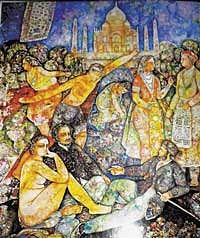Free of conflict

Not too many Indian artists have had their works sharing wall space with the creations of Picasso, Chagall and Miro. Sakti Burman can recall that honour at a showing in Japan in 1997. The artist who has lived much of his life in France held his first solo exhibition in Kolkata in 1954. The inspiration of numerous solo exhibitions around the world, he has been invited to participate at the Paris Biennale, Indian International Triennale, Salon d’Automne, Salon de la Jeune Peinture and Salon Comparaisons.
He was invited to participate in Sigmund Freud’s Interpretation of Dreams an exhibition organised by University Art Museum, Birghamton, New York, at the Historisches Museum, Vienna in 2000. Limited edition suites of his lithographic illustrations of poems by Rabindranath Tagore and Mallarme have been published.
Born in Kolkata in 1935, Burman grew up in Dibrugarh, and graduated in painting from the Government College of Arts and Crafts, Kolkata, in 1956. The same year, he went to study at Ecole Nationale Superieure des Beaux-Arts, Paris and was awarded the Prix des Etrangers. From Paris, Italy and its Renaissance frescoes were short and frequent visits away. Through his works he returns to the collective bank of his life, including the culture of the land he was born into and the land he lives in. Though he lives, since the mid-50s, in Paris, he holds an Indian passport and is often in the land of his birth. The India of his childhood and youth and the Europe of his present life constantly interweave and hold dialogues.
There is an innocence in his work that is charming. But Burman’s work is not just another fresco, or a visit to Ajanta caves. He uses contemporary colours. His world is free of conflict.
The sheer size and detailing of Sakti Burman’s work leaves one captivated. Parable and legend, myth and contemporary reality blend seamlessly to tell their own story. Some of the metaphors are from the land of his birth while others, like the centaur, have been imbibed later. The tiger, or an animal similar to it, appears time and again. The tiger in most of Burman’s works is not the tiger of Blake’s forests. In The Hunt, for example, he first planned to have the hunters facing the young girl, but later, disturbed by the fact that it loaded the composition with “too much danger,” had her turn her back to them.
Burman’s craft is as important as the art. He points out details in technique and texture with child-like enthusiasm. The marbling, he explains goes back a long way when he took in Renaissance frescoes and the works he saw at Ajanta, Ellora, Konark and Amaravati.
His earlier work, exuberant with the inspiration of Renaissance brilliance, showed more European influence. From the early 1960s, he developed what has become his signatory style. Children and child-like naivete feature regularly in his work.
Sometimes it is an obvious reference, like the composition with Estelle, his grand daughter. That brings us to Sakti Burman, the social and sociable painter whose life and work are replete with people, animals and family. There are frequent references to his wife, artist Maite Delteil. Through the beareded face that could and is often his, he keeps his presence alive in his works although often, the face takes on a partridge-like body. Yet, he makes light of any attempt to analyse his works. “There’s no message. I’m joking about myself. Take everything lightly.”
Deccan Herald is on WhatsApp Channels| Join now for Breaking News & Editor's Picks